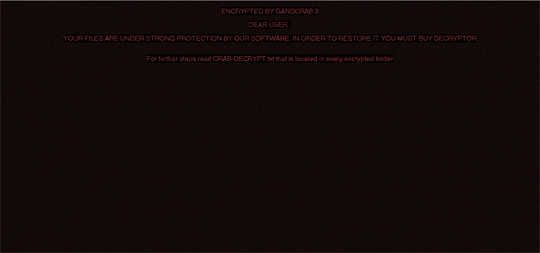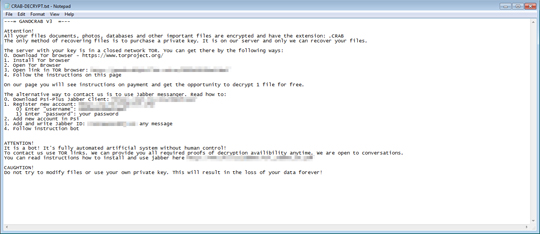RANSOM_GANDCRAB.THDCOAH
Gen:Variant.Ursu.192325 (Bitdefender), Mal/GandCrab-B (Sophos_Lite)
Windows


Threat Type: Ransomware
Destructiveness: No
Encrypted:
In the wild: Yes
OVERVIEW
This Ransomware steals certain information from the system and/or the user.
It connects to certain websites to send and receive information. It deletes itself after execution.
It encrypts files found in specific folders.
TECHNICAL DETAILS
Installation
This Ransomware drops the following copies of itself into the affected system:
- %Application Data%\Microsoft\{Random Characters}.exe
(Note: %Application Data% is the Application Data folder, where it usually is C:\Documents and Settings\{user name}\Application Data on Windows 2000, Windows Server 2003, and Windows XP (32- and 64-bit); C:\Users\{user name}\AppData\Roaming on Windows Vista (32- and 64-bit), Windows 7 (32- and 64-bit), Windows 8 (32- and 64-bit), Windows 8.1 (32- and 64-bit), Windows Server 2008, and Windows Server 2012.)
It adds the following mutexes to ensure that only one of its copies runs at any one time:
- Global\pc_group={Machine Workgroup}&ransom_id={16 hex values generated by the malware}
Autostart Technique
This Ransomware adds the following registry entries to enable its automatic execution at every system startup:
HKEY_LOCAL_MACHINE\SOFTWARE\Microsoft\
Windows\CurrentVersion\RunOnce
{Random Characters} = %Application Data%\Microsoft\{Random Characters}.exe
Information Theft
This Ransomware steals the following information:
- Machine Workgroup
- Anti Virus Software
- System Language
- Public IP Address
- Username
- Machine Name
- Machine Keyboard Layout
- OS Version and Platform
- Drive letters of drives, type, capacity, and free space
Stolen Information
This Ransomware sends the gathered information via HTTP POST to the following URL:
- http://{BLOCKED}r.bit/{"action"=result&e_"files"=%d&e_"size"=%I64u&e_"time"="time executed"}
Other Details
This Ransomware connects to the following URL(s) to get the affected system's IP address:
- Ipv4bot.whatismyipaddress.com
It connects to the following website to send and receive information:
- http://{BLOCKED}der.bit/
- http://{BLOCKED}ware.bit/
It does the following:
- It checks for the presence of the following antivirus and security applications:
- AVP.EXE
- ekrn.exe
- avgnt.exe
- ashDisp.exe
- NortonAntiBot.exe
- Mcshield.exe
- avengine.exe
- cmdagent.exe
- smc.exe
- persfw.exe
- pccpfw.exe
- fsguiexe.exe
- cfp.exe
- msmpeng.exe
- The malware does not proceed to its encryption routine if it detects a Russian keyboard layout and if it fails to communicate with the server
- This malware restarts the system using the following command:
- shutdown -r -t 60 -f
- It changes the wallpaper of the victim after restarting the system.
- It avoids encrypting files found in the following folders:
- ProgramData
- IETldCache
- Boot
- Program Files
- Tor Browser
- Ransomware
- All Users
- Local Settings
- Windows
- Local AppData
- It avoids encrypting the following files:
- desktop.ini
- autorun.inf
- ntuser.dat
- iconcache.db
- bootsect.bak
- boot.ini
- ntuser.dat.log
- Thumbs.db
- CRAB-DECRYPT.txt
- It encrypts all files except files with the following extensions:
- .ani
- .cab
- .cpl
- .cur
- .diagcab
- .diagpkg
- .dll
- .drv
- .hlp
- .ldf
- .icl
- .icns
- .ico
- .ics
- .lnk
- .key
- .idx
- .mod
- .mpa
- .msc
- .msp
- .msstyles
- .msu
- .nomedia
- .ocx
- .prf
- .rom
- .rtp
- .scr
- .shs
- .spl
- .sys
- .theme
- .themepack
- .exe
- .bat
- .cmd
- .CRAB
- .crab
- .GDCB
- .gdcb
- .gandcrab
- .yassine_lemmou
- It deletes shadow copies by executing the following command:
- cmd.exe /C WMIC.exe shadowcopy delete
- It executes the following commands to pop up the ransom note of the malware on Internet Explorer after restarting by executing the following commands:
- iexplore.exe /C iexplore.exe SCODEF:3124 CREDAT:14337
- iexplore.exe /C ie4uinit.exe -ShowQLIcon
- It disables the access of Internet Explorer homepage by executing the following commands:
- {Malware File Name}.exe /C iexplore.exe -nohome
It performs DNS requests to the following sites:
- {BLOCKED}.{BLOCKED}servers.ru
- {BLOCKED}.{BLOCKED}.238.18
- {BLOCKED}.{BLOCKED}.214.39
- {BLOCKED}.{BLOCKED}.225.249
It deletes itself after execution.
Ransomware Routine
This Ransomware encrypts files found in the following folders:
- It will check the drive type of all drives from A to Z and will only encrypt the ones with the following drive type:
- Removable Drives
- Fixed Drives
- Network Drives
- Ramdisk Drives
It appends the following extension to the file name of the encrypted files:
- .CRAB
It leaves text files that serve as ransom notes containing the following text:
- {Encrypted Directory}\CRAB-DECRYPT.txt
NOTES:
SOLUTION
Step 1
Before doing any scans, Windows XP, Windows Vista, and Windows 7 users must disable System Restore to allow full scanning of their computers.
Step 2
Note that not all files, folders, and registry keys and entries are installed on your computer during this malware's/spyware's/grayware's execution. This may be due to incomplete installation or other operating system conditions. If you do not find the same files/folders/registry information, please proceed to the next step.
Step 3
Restart in Safe Mode
Step 4
Delete this registry value
Important: Editing the Windows Registry incorrectly can lead to irreversible system malfunction. Please do this step only if you know how or you can ask assistance from your system administrator. Else, check this Microsoft article first before modifying your computer's registry.
- In HKEY_CURRENT_USER\Software\Microsoft\Windows\CurrentVersion\Run
- Java Platform Auto Updater = {Current Malware Directory}\{Malware Name}.exe
- Java Platform Auto Updater = {Current Malware Directory}\{Malware Name}.exe
Step 5
Search and delete this file
- In HKEY_CURRENT_USER\Software\Microsoft\Windows\CurrentVersion\Run
- Java Platform Auto Updater = {Current Malware Directory}\{Malware Name}.exe
- Java Platform Auto Updater = {Current Malware Directory}\{Malware Name}.exe
Step 6
Restart in normal mode and scan your computer with your Trend Micro product for files detected as RANSOM_GANDCRAB.THDCOAH. If the detected files have already been cleaned, deleted, or quarantined by your Trend Micro product, no further step is required. You may opt to simply delete the quarantined files. Please check this Knowledge Base page for more information.
Step 7
Restore encrypted files from backup.
Did this description help? Tell us how we did.




